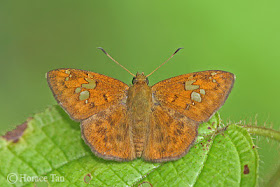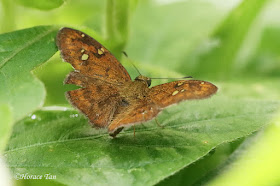The Indian Red Admiral lands in Singapore

Around this time last year, Singapore had an American "Lady" visiting us. The Painted Lady (Vanessa cardui) was seen at three separate locations in Singapore and successfully photographed by ButterflyCircle members.
It was therefore without much surprise that again, another similar-looking butterfly was seen again near the same location where the Painted Lady was spotted last year. It was photographed on 23 Dec 08 by ButterflyCircle member James Chia, and then on a subsequent day by Sunny Chir and Federick Ho.

However, upon closer scrutiny, this was no American visitor! The species was confirmed to be the Indian Red Admiral (Vanessa indica indica Herbst, 1794), a close relative of the Painted Lady!

Described on Wikipedia as being "found in the higher altitude regions (above 2000 feet) of India including the Nilgiri hills in southern India. It also occurs on smaller hill ranges in Peninsular India such as the Nandi hills near Bangalore", it again poses another mystery of how it got this far south to Singapore! Another website records it as "East and South Asia, and also the Canary Islands and Madeira; migrates actively northwards and appears regularly in SE Siberia (up to Kamchatka)." It has also been reported from Thailand, Taiwan, Hong Kong and mainland China and as far east as Japan.

As the local butterfly parks are not known to feature this species as part of their live collections, it is unlikely to have been an escapee from these facilities. Whilst it could have been introduced by human agency or accidentally stowed away on a ship that was passing this way, the Indian Red Admiral belongs to a genus of butterflies that is known for their strong migratory tendencies with large flight ranges, and it would not be totally impossible that this species somehow flew all the way here from the Indian SubContinent! It could also have come from Thailand, the nearest neighbouring country where the species is known to exist. But whatever the case may be, Singapore records a new species in the Checklist with this single specimen of the Indian Red Admiral.
 On the Butterflies of Sri Lanka website, the Indian Red Admiral is reported to be "... an active butterfly that may be seen day after day in the same location". This habit appears to have held true, as the same individual was seen over 3 days at an urban hill park in Singapore.
On the Butterflies of Sri Lanka website, the Indian Red Admiral is reported to be "... an active butterfly that may be seen day after day in the same location". This habit appears to have held true, as the same individual was seen over 3 days at an urban hill park in Singapore.
The Indian Red Admiral resembles the Painted Lady but the ground-colour is darker both on the upper and under sides, and the orange markings deeper and richer. A medium sized dark gray brown butterfly with reddish orange and white markings. The forewing has orange patches forming a post-discal band, and white apical and subapical spots. The hindwing above is mainly light brown with a series of black submarginal spots on an orange submarginal band. The underside has a blotched appearance with many shades and patterns of brown and gray.

It has a strong flight, and may be territorial, but often stops to feed. It is observed to be partial to human perspiration and has been noted to settle on humans to feed on sweat.

The caterpillars of this species are known to feed on nettles (Family : Urticaceae).
So Singapore welcomes the Indian Red Admiral and has species #285 recorded in its Checklist. It is not known where the individual has flown to, or whether it has ended up in the stomach of a hungry predator or it may have continued its journey southwards. But we hope that we will continue to get visits from these strong migratory visitors during the North-East Monsoon season, where the northern winds may carry unexpected butterflies to our little Red Dot of an island in the sun!

A fitting end to the butterfly biodiversity in Singapore for 2008!
Happy New Year! : )
Text by Khew SK ; Photos by James Chia, Sunny Chir and Federick Ho
References :



























































